1. Simple equations
- Books Name
- CBSE Class 7 Mathematics Book
- Publication
- Param Publication
- Course
- CBSE Class 7
- Subject
- Mathmatics
Variable
It means something that can vary or change. It takes different numerical values. Usually variables are denoted by letters of the alphabets. For example, x, y, z, a, b, c etc.
EXPRESSION
Expressions are obtained by placing mathematical operators like addition, subtraction, multiplication and division on the variables.
For example, 2x + 3
This expression is formed by multiplying x by 2 and then adding 3 to the product.
EQUATION
An equation has always an equality sign. An equation can be formed by using equality sign between two expressions with the condition that these two expressions should have equal value. Atleast one of the two expressions should have equal value. The equality sign means the value of the expression to the left of the sign is equal to the value of the expression to the right of the sign.
An equation remains the same, when the expressions on the left and on the right are interchanged.
For example, 2x + 3 = 5x –5 is same as 5x–5 = 2x +3
1. Simple equations
- Books Name
- class 7 Mathematics Book
- Publication
- ReginaTagebücher
- Course
- CBSE Class 7
- Subject
- Mathmatics
Chapter 4
Simple Equations
Introduction to simple equations
An equation is a statement of uniformity between two mathematical expressions containing one or more variables.
Rules for simple equation,
e.g. 2x – 3 = 5, 3x + 9 = 11, 4y + 2 = 12
Two expressions on both sides of the equation should have equal value and at least one of the expressions must have a variable. An equation remains the same if the LHS and the RHS of the equation are interchanged.
Equation
An equation is a statement which states that two expressions are equal.
Solving an equation
The value of the variable for which the left hand side of an equation is equal to its right hand side is called the solution of that equation.
For example : For the equation, x + 2 = 6, x= 4 is the solution.
An equation remains unchanged if :
- The same number is added to each side of the equation.
- The same number is subtracted from each side of the equation.
- The same number is multiplied to each side of the equation
- Each side of equation is divided by the same non-zero number.
Solving an equation by shortcut method (transposing terms)In an equation if a positive sign is transported from one side to other, its sign becomes negative.
- In an equation if a negative sign is transported from one side to other, its sign becomes positive.
- In an equation if a term in multiplication is transported from one side to other, it goes in division.
- In an equation if a term in division is transported from one side to other, it goes in multiplication .
- While solving an equation with the variable on both the sides, transpose the terms containing the variable to one side and the constants on the other side.
Verbal statement vs algebraic statements
Example:
Kathir is twice taller than Krishna. That is Kathir height is two times larger than Krishna's height. Now, this is known as a verbal statement.
If you write the above verbal statement in an algebraic statement we get,
Let the height of the Krishna is x.
Therefore Kathir height = 2×HeightofKrishna=2×x=2x.
In the above example, we understood that normally we use the verbal statement to mention any mathematical operation, then we translate this verbal statement to an algebraic statement to find the unknown value.
Now let's see a few examples of how we are using the verbal and algebraic statement in the mathematical operation.
[Note: In a verbal statement the unknown value x is represented as some number or a number].
Addition keywords: Sum, total, added, increased, more than, etc.

Subtraction keywords: Minus, Decreased by, less than, the difference of, subtracted, etc.

Multiplication keywords: Multiplied by, The product of, Times, Thrice, Twice etc.

Division keywords: Divided by, The ratio of, The quotient of, etc.

Using these above, we can also make another operation that is,
Equals keywords: Equals, Is the same as, yields.

properties of linear equation
- Books Name
- CBSE Class 7 Mathematics Book
- Publication
- Param Publication
- Course
- CBSE Class 7
- Subject
- Mathmatics
Properties of linear equations
1. We can add the same number to both sides of the equation.
Consider the example x – 8 = 12
Additing 8 to both sides of the equation,
We have x – 8 + 8 = 12 + 8
⇒ x + 0 = 20
⇒ x = 20
2. We can subtract the same number from both sides of the equation.
Ex. z + 7 = 8
Subtracting 7 from both sides of the equation, we have
z + 7 = 8
⇒ z + 7 – 7 = 8 – 7
⇒ z + 0 = 1
⇒ z = 1
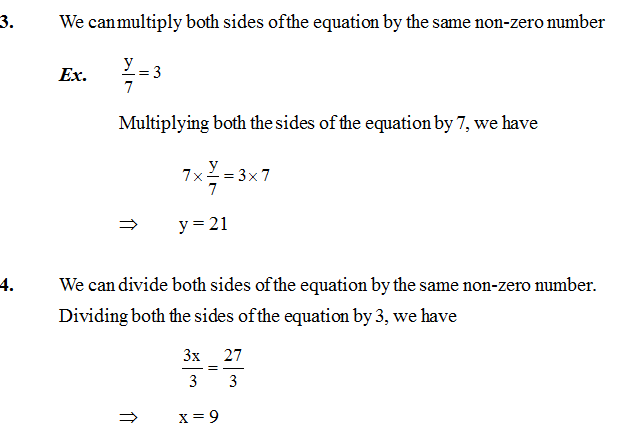
how to solve an equation
- Books Name
- CBSE Class 7 Mathematics Book
- Publication
- Param Publication
- Course
- CBSE Class 7
- Subject
- Mathmatics
How to solve an equation
1. Trial and error method
![]()
We substitute various values for x and stop only when the value satisfies the equation.
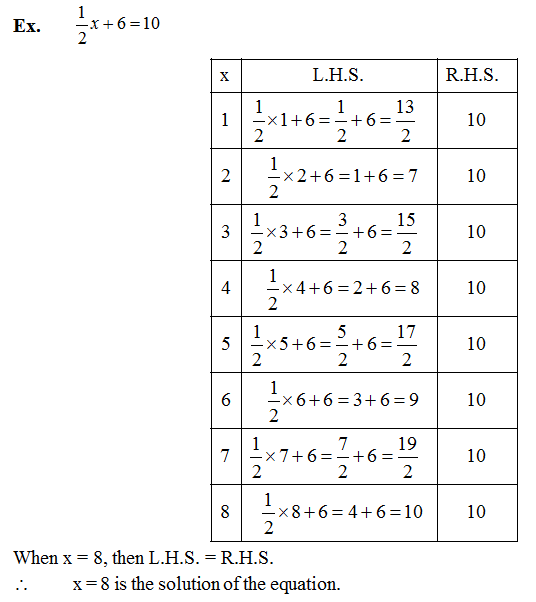
2. Transposition method: Transposing a number means moving an expression to the other side of the equation
For example, x +2 = 3
By transposing 2 from LHS to RHS, we get
x = 3 –2 (On transposing +2 become –2)
x = 1
Some example of transpostions
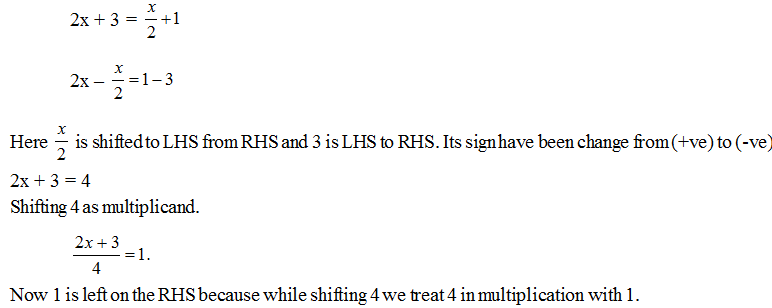
transposition rules
- Books Name
- CBSE Class 7 Mathematics Book
- Publication
- Param Publication
- Course
- CBSE Class 7
- Subject
- Mathmatics
Transposition rules:
(i) While shifting (+ve), (-ve) terms from LHS to RHS its sign change to (-ve), (+ve) respectively.
(ii) While moving the expression from LHS to RHS, which are in multiplication or division expression which are in multiplication moves in division.

Important Points
- Books Name
- CBSE Class 7 Mathematics Book
- Publication
- Param Publication
- Course
- CBSE Class 7
- Subject
- Mathmatics
Important points
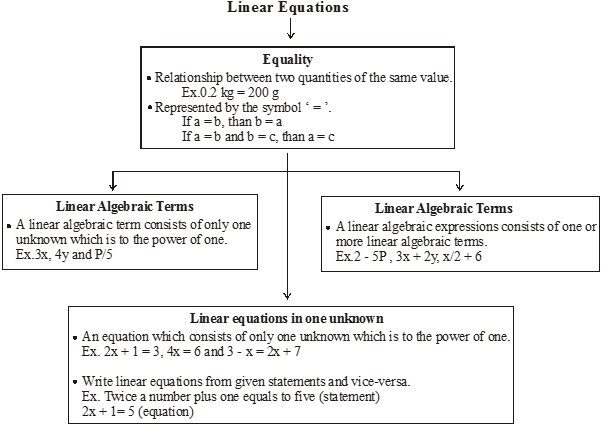
application of simple equation
- Books Name
- CBSE Class 7 Mathematics Book
- Publication
- Param Publication
- Course
- CBSE Class 7
- Subject
- Mathmatics
Application of Simple Equation
Illustration 1
Five times of a number is 3 more than the two times of a number
Solution
Let the unknown number is x
then five times of number is 5x
and two times of number is 2x
and the sum of 2x and 3 is 5x
⇒ 5x = 2x + 3
For solving this equation we transpose +2x from RHS to LHS
⇒ 5x – 2x = 3 ⇒ 3x = 3 ⇒ x = 1
Illustration 2
Construct an equation from the following sentences
(i) The sum of 5 and a number is 11
(ii) If 7 is subtracted from a number then we get 2
(iii) The sum of three times of a number and 5 is equal to 8
(iv) One fifth of a number is equal to 2
Solution
(i) Let us say the numbers is x
Sum of 5 and a number = 5 + x
So the equation is 5 + x = 11
(ii) Let the number is y
by subtracting 7 from the number we get
y –7
so the equation is y–7 = 2
(iii) Let number is z
three times = 3z
Sum of 5 and 3z is 3z + 5
So the equation is 3z + 5 = 8
(iv) Let the number is x
One fifth of number is x/5
So the equation is x/5 = 2
Illustration 3
Solve: 3x –2 = 1 and check the result.
Solution
By transposing (–2) to RHS
3x –2 + 2 = 1 + 2 ⇒ 3x = 3
Divide both side by 3
![]()
Check putting value of x = 1 in the LHS of the equation
LHS = 3 × 1 –2 = 3 –2 = 1 = RHS
LHS = RHS
Illustration 4
A’s age is 3 yrs less than two times A’s friend’s age. If A’ age is 5 yrs. Set up an equation to find A’ friend’s age.
Solution
Let the A’s friend age is x yrs.
Two times of x is 2x.
Age of A is 3 yrs less than 2x
So the equation is 2x –3 = 5
Where x is the A’s friend age.
Illustration 5
One number is 3 less than the two times of the other. If their sum is increased by 7, the result is 37. Find the numbers.
Solution
Let one number = x
other number = 2x – 3
⇒ (x + 2x – 3) + 7 = 37 ⇒ 3x + 4 = 37 ⇒ 3x = 37 – 4 ⇒ 3x = 33 ⇒ x = 11
∴ 2x – 3 = 2 ´ 11 – 3 = 22 – 3 = 19
∴The two numbers are 11 and 19.
Illustration 6
Construct 2 equations starting with x = 1
Solution
(i) Multiply both sides by 2
2x = 2
Subtract both sides by 1
2x – 1 = 1
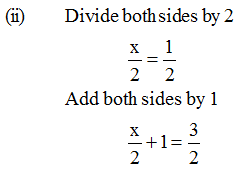

 Param Publication
Param Publication
 ReginaTagebücher
ReginaTagebücher
